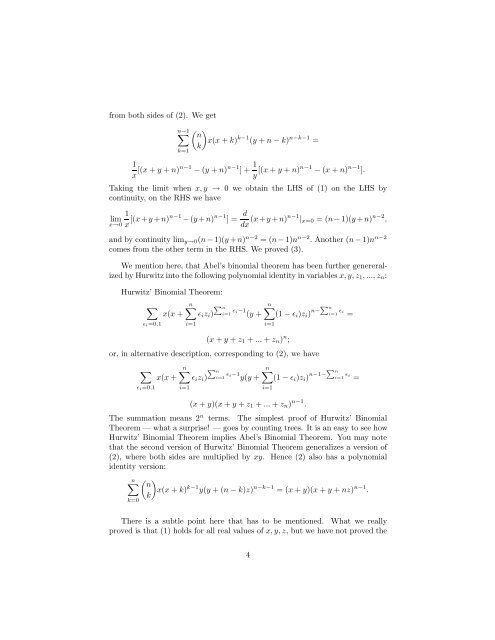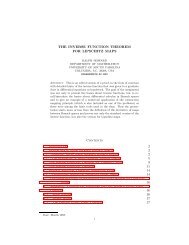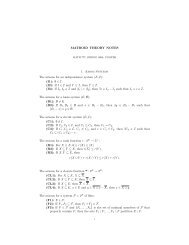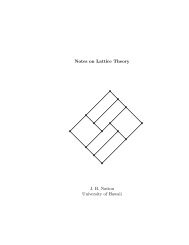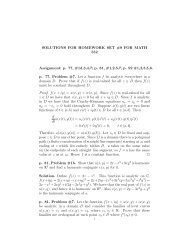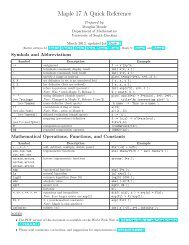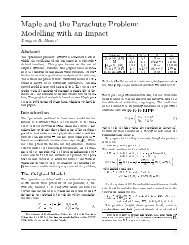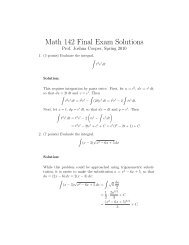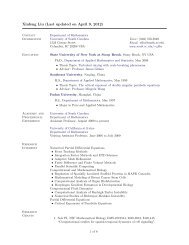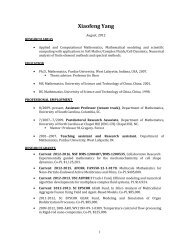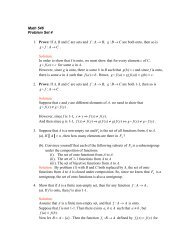Abel's binomial theorem The following was assigned as homework ...
Abel's binomial theorem The following was assigned as homework ...
Abel's binomial theorem The following was assigned as homework ...
Create successful ePaper yourself
Turn your PDF publications into a flip-book with our unique Google optimized e-Paper software.
from both sides of (2). We get<br />
n−1 �<br />
� �<br />
n<br />
x(x + k)<br />
k<br />
k−1 (y + n − k) n−k−1 =<br />
k=1<br />
1<br />
x [(x + y + n)n−1 − (y + n) n−1 ]+ 1<br />
y [(x + y + n)n−1 − (x + n) n−1 ].<br />
Taking the limit when x, y → 0 we obtain the LHS of (1) on the LHS by<br />
continuity, on the RHS we have<br />
1<br />
lim<br />
x→0 x [(x + y + n)n−1 − (y + n) n−1 ]= d<br />
dx (x + y + n)n−1 |x=0 =(n−1)(y + n) n−2 ,<br />
and by continuity limy→0(n − 1)(y + n) n−2 =(n−1)nn−2 . Another (n − 1)nn−2 comes from the other term in the RHS. We proved (3).<br />
We mention here, that Abel’s <strong>binomial</strong> <strong>theorem</strong> h<strong>as</strong> been further genereralized<br />
by Hurwitz into the <strong>following</strong> polynomial identity in variables x, y, z1, ..., zn:<br />
Hurwitz’ Binomial <strong>The</strong>orem:<br />
�<br />
n�<br />
x(x +<br />
ɛi=0,1<br />
i=1<br />
�n ɛizi) i=1 ɛi−1 (y +<br />
n�<br />
i=1<br />
(1 − ɛi)zi) n−� n<br />
i=1 ɛi =<br />
(x + y + z1 + ... + zn) n ;<br />
or, in alternative description, corresponding to (2), we have<br />
�<br />
ɛi=0,1<br />
x(x +<br />
n�<br />
i=1<br />
�n ɛizi) i=1 ɛi−1 y(y +<br />
n�<br />
i=1<br />
(1 − ɛi)zi) n−1−� n<br />
i=1 ɛi =<br />
(x + y)(x + y + z1 + ... + zn) n−1 .<br />
<strong>The</strong> summation means 2n terms. <strong>The</strong> simplest proof of Hurwitz’ Binomial<br />
<strong>The</strong>orem — what a surprise! — goes by counting trees. It is an e<strong>as</strong>y to see how<br />
Hurwitz’ Binomial <strong>The</strong>orem implies Abel’s Binomial <strong>The</strong>orem. You may note<br />
that the second version of Hurwitz’ Binomial <strong>The</strong>orem generalizes a version of<br />
(2), where both sides are multiplied by xy. Hence (2) also h<strong>as</strong> a polynomial<br />
identity version:<br />
n�<br />
� �<br />
n<br />
x(x + k)<br />
k<br />
k−1 y(y +(n−k)z) n−k−1 =(x+y)(x + y + nz) n−1 .<br />
k=0<br />
<strong>The</strong>re is a subtle point here that h<strong>as</strong> to be mentioned. What we really<br />
proved is that (1) holds for all real values of x, y, z, but we have not proved the<br />
4


